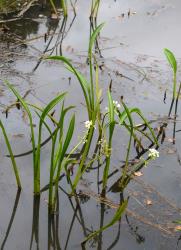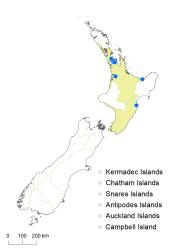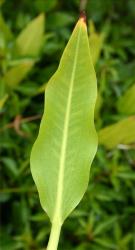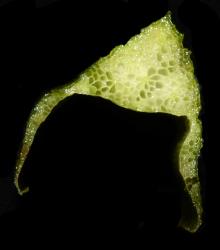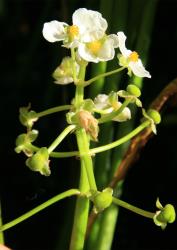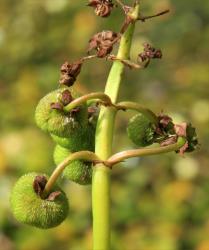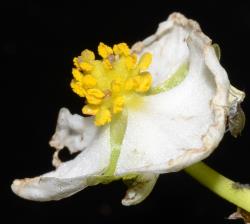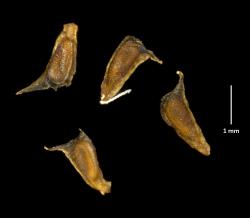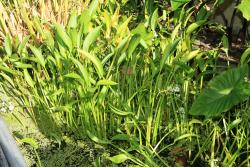- Taxon
- Weed
- Gallery
- ≡ Sagittaria graminea var. platyphylla Engelm. in Gray, Manual [Gray], ed. 5, 494 (1867)
Erect, perennial herb to 150 cm, with corms and stolons. Emergent leaves sheathing, petiolate; lamina 40–210 long, 20–100 mm wide, narrow or broad-elliptic, ovate or linear-ovate, glabrous, base cuneate and gradually tapering or occasionally sub-cordate, apex acuminate or acute, margin entire; petiole 240–657 mm long, 5.0–10 mm wide, trigonous, septate, conspicuously winged, glabrous. Submersed phyllodial leaves ribbon-like, 100–410 mm long, 6.0–23 mm wide, apex acuminate to obtuse, margin entire. Inflorescence a whorled raceme, pyramidal, bracteate, 50–150 mm long, 30–120 mm wide, 3–9 whorls of three pedicellate flowers; scape 150–650 mm long, 3–6 mm wide, erect, trigonous, emergent. Staminate flowers about 20 mm diameter, sterile carpels absent, pedicels spreading to ascending 0.5–0.8 mm wide, terete; sepals 4–9 mm long, 3–6 mm wide, ovate, concavo-convex, with conspicuous membranous margins; petals white, 8–10 mm long, 10–12.5 mm wide, broad-ovate with a narrow claw, delicate, apex rounded, irregularly crenate; stamens 17–41; filaments 1.5–2.5 mm long, dilated, densely pubescent; anthers yellow, 1.0–1.5 mm long, elliptic. Carpellate flowers, carpels many, staminodes absent, pedicels spreading, becoming recurved in fruit 1.0–2.0 mm wide, distinctly thicker than staminate pedicels, terete; sepals 5–8 mm long, 3–5 mm wide, ovate, concavo-convex, with membranous margins, spreading to reflexed, not enclosing fruiting head; petals white, delicate, deciduous 4.5–5.0 mm long, 5.5–6.0 mm wide, broad-ovate with a narrow claw, apex rounded. Fruiting head 5–15 mm diameter. Achenes 2.0–2.5 mm length, 0.5–1.5 mm wide, obovate with a lateral beak, without keel, winged, tuberculate, brown. Seeds about 1.0 mm long, 0.5 mm wide, uncinate, brown.
Sagittaria platyphylla has non-lobed elliptic or ovate leaves (which can be narrow or broad), distinguishing it from other large species of Sagittaria present in New Zealand: S. montevidensis and an unidentified species (in the Sagittifolia group), both of which have obviously lobed, arrow-shaped leaves. There is no coloured spot on the petals of S. platyphylla, in contrast to S. montevidensis, and the petiole of Sagittaria platyphylla is trigonous rather than D-shaped (semi-terete). Sagittaria platyphylla emergent leaves are like those of Alisma spp., especially A. lanceolatum. The petiole of S. platyphylla is trigonous in contrast to the D-shaped (semi-terete) petioles of Alisma spp. When flowering, Alisma spp. have broader, taller inflorescences with smaller, but many more, pink or lilac flowers rather than white.
Sagittaria platyphylla is a designated unwanted organism in New Zealand under the Biosecurity Act, is banned from sale and distribution, and is targeted for eradication wherever it occurs.
North Island: Auckland – Stanmore Bay, Whangaparāoa Peninsula, Auckland City, North Shore (Wairau Catchment), Glenfield, Pakuranga Stream, Waikato (near Kaniwhaniwha); Volcanic Plateau – Opotiki; southern North Island – Marton, Hawke's Bay (Te Mata Park).
iNaturalist record: https://inaturalist.nz/observations/9764176
Wetlands, in streams and along edges of waterways, ponds, drains.
Notes: spreading by seed in waterways, and by rhizomes and corm fragmentation.
AK 185308, P.D. Champion, Tamaki, Glenfield, Becroft Park, 1989.
Flowering: Dec.–Apr. Fruiting: Mar.–May.
2n = 22 (Fedorov 1969)



